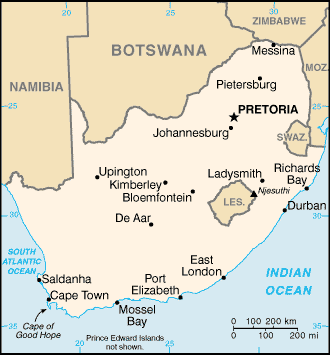 <<back | index | next>> South AfricaBackground
Wind EnergySouth Africa has the potential to become a "wind powerhouse" because of its abundance of wind resources, available land and existing infrastructure, says Hermann Oelsner, an independent electricity producer on a wind farm near Darling, north of Cape Town. Our huge wind resources and the short time it takes to build wind farms makes wind energy a sensible option, says Oelsner, chairman of the Darling Independent Power Producer company. He says a 100MW wind farm can be built in a year...more>> However, South Africa does not yet commercially generate electricity from wind power. About 400 kilowatts (kW) of small wind turbines for power generation have been installed, but are not yet connected to the power grid. Current uses of wind power include about 300,000 wind pumps for livestock and community water use. Significant potential exists for generating electricity from wind energy, however, especially along the coasts and the Drakensberg escarpment, which have average annual wind speeds in excess of 4 meters per second (m/s) with some localized areas having speeds greater than 6 m/s. The areas near Cape Town and Durban have the best potential for wind sites. Eskom and the Department of Minerals and Energy are investigating the possibilities for use of wind power for electricity generation. A study has been conducted in the Darling district of the Western Cape for constructing a wind farm and connecting it to the national grid. The project is now in the investment phase. The government is examining wind farms as a means of addressing peak loads on the national electricity grid...more>>
Pumping water - the traditional use of wind
energy
|
| Potential Wind Resources: | Total Electric Usage (2002) | Population (July 2003) | Energy usage /person/year |
| N/A | 181,200 GWh | 42,768,678 | 4.2367 MWh |
Energy Conversion:
| 1 TWh (terawatt-hour) | 1000 GWh (gigawatt-hour) |
| 1 GWh (gigawatt-hour) | 1000 MWh (megawatt-hour) |
| 1 MWh (megawatt-hour) | 1000 KWh (kilowatt-hour) |
| 1 KWh (kilowatt-hour) | 1000 Wh (watt-hour) |
References and Additional Information about Wind Resources in South Africa:
Nationmaster: http://www.nationmaster.com/country/sf/Energy
Renewable Energy World - Wind Energy in South Africa: http://www.jxj.com/magsandj/rew/2001_03/wind_energy_in_south_africa.html
Fossile Energy - An Energy Overview of the Republic of South Africa: http://www.fe.doe.gov/international/safrover.html
Energy Breakdown Chart of South Africa: Energy Chart
Energy Grid Map of South Africa
If you speak another language fluently and you liked this page, make
a contribution by translating
it! For additional translations check out FreeTranslation.com
(Voor vertaling van Engels tot Nederlands)
(For oversettelse fra Engelsk til Norsk)
(Для дополнительных
переводов проверяют
FreeTranslation.com )


 General
Information The Republic of South Africa is about
twice the size of Texas and has a population of
about 42.7 million. South Africa is located at
the southern tip of Africa, and is bordered by
Namibia, Botswana, and Zimbabwe to the north,
Mozambique and Swaziland to the east, the Indian
Ocean to the Southeast, and the Atlantic Ocean
to the Southwest. The country of Lesotho is completely
enclaved in the east-central part of South Africa.
South Africa consists of nine provinces; these
are shown in Figure 1. The capital city, Pretoria,
is located in the northeast part of the country
and has a population of about 526,000. South Africa's
currency, the Rand, has an exchange rate of about
7.17 Rands per U.S. dollar (as of October 2003).
The GDP (based on purchasing power parity) is
$412 billion, which ranks it 20th among 212 countries
and territories.
General
Information The Republic of South Africa is about
twice the size of Texas and has a population of
about 42.7 million. South Africa is located at
the southern tip of Africa, and is bordered by
Namibia, Botswana, and Zimbabwe to the north,
Mozambique and Swaziland to the east, the Indian
Ocean to the Southeast, and the Atlantic Ocean
to the Southwest. The country of Lesotho is completely
enclaved in the east-central part of South Africa.
South Africa consists of nine provinces; these
are shown in Figure 1. The capital city, Pretoria,
is located in the northeast part of the country
and has a population of about 526,000. South Africa's
currency, the Rand, has an exchange rate of about
7.17 Rands per U.S. dollar (as of October 2003).
The GDP (based on purchasing power parity) is
$412 billion, which ranks it 20th among 212 countries
and territories. 
